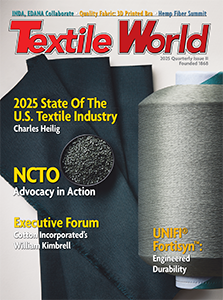 Avondale Chairman, PresidentandCEO G. Stephen Felker accepts the Textile World 2002 Innovation
Avondale Chairman, PresidentandCEO G. Stephen Felker accepts the Textile World 2002 InnovationAward from Textile World Chairman Douglas C. Billian.Textile World Magazine presented Avondale
Mills, Inc. with the 2002 Innovation Award on Friday, June 28th, at an awards luncheon held at the
Cherokee TownandCountry Club in Atlanta.Executives were on hand from Avondale Mills; American
Savio; Elbit Vision Systems; DyStar; Ford, TrimbleandAssociates Inc.; HSGM Inc.; Noveon; Picanol of
America Inc.; R.L. Stowe Mills Inc.; Rieter; Savio; Steel Heddle; Sulzer Textile; and Zima Corp.,
as well as the Textile Industries Media Group. G. Stephen Felker, chairman, president and CEO
of Avondale Mills, accepted the award on behalf of the company.




